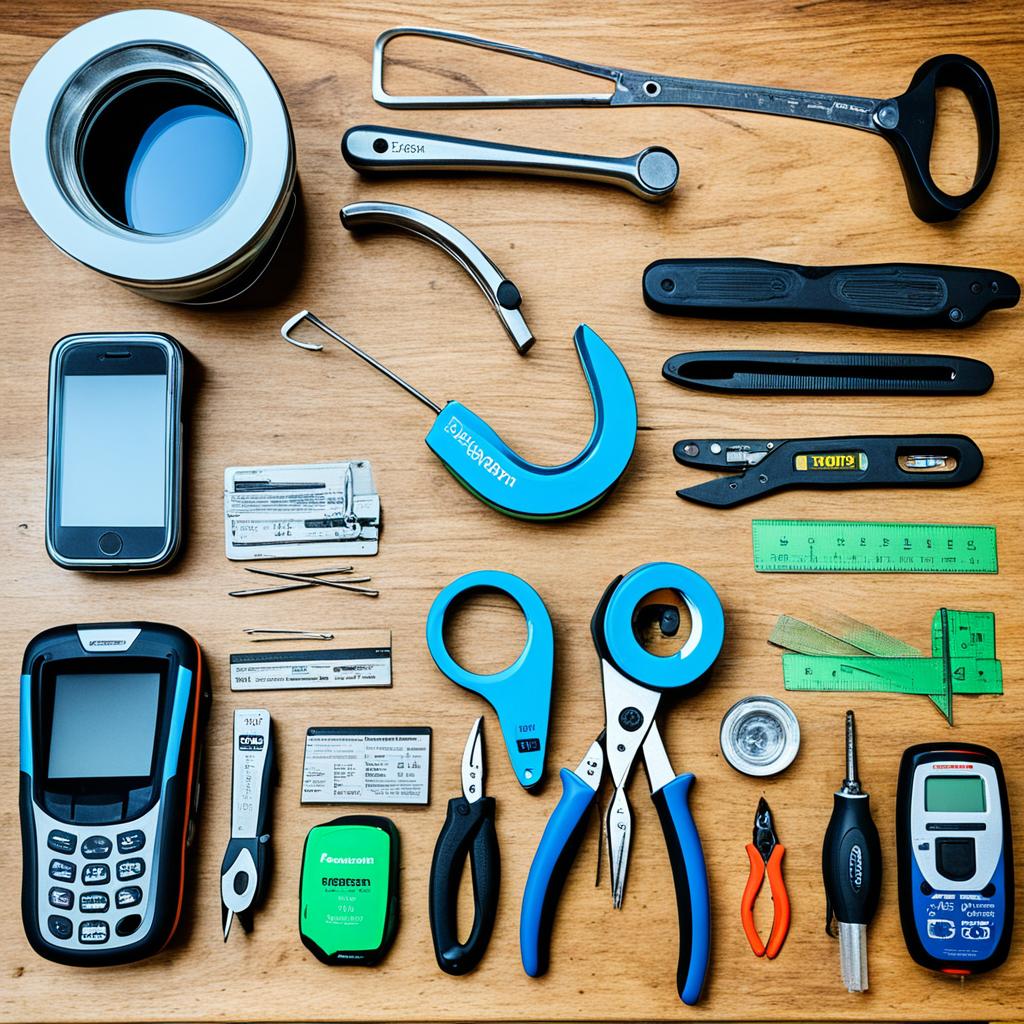Are you looking to make some extra cash? Have you ever considered thrift store flipping? It’s a fun and lucrative side hustle that allows you to turn second-hand treasures into online profits. With the right strategies and knowledge, you can maximize your thrift store flipping profits and build a successful online business.
Thrift store flipping involves finding unique and valuable items at thrift stores and reselling them online at a higher price. It’s all about spotting hidden gems that others may overlook. And the best part? You can do it from the comfort of your own home, on your own time.
If you’re ready to dive into the world of thrift store flipping, I’ve got you covered. In this article, I’ll share tips and techniques to help you find profitable thrift store items, identify lucrative categories, develop essential skills, and more. You’ll discover the secrets to building a successful thrift store flipping business and maximizing your profits along the way.
Key Takeaways:
- Thrift store flipping is a popular side hustle that involves finding items at thrift stores and reselling them online.
- By implementing the right strategies, you can maximize your profits from thrift store flipping.
- Tips for finding profitable thrift store items include checking online prices, shopping in higher-end neighborhoods, and taking advantage of discount days.
- Profitable categories for thrift store flipping include books and textbooks, picture frames, video games, and brand-name clothing.
- Essential skills for thrift store flipping include spotting good deals, researching comparables, packaging items, and negotiating.
Tips for Finding Profitable Thrift Store Items
When it comes to flipping thrift store finds for profit, having a solid strategy is key. By implementing these tips, you can increase your chances of finding items with high resale value and maximizing your profits.
1. Always Check Online Before Purchasing
Before you make a purchase at a thrift store, take a moment to do a quick search online. This will give you a better idea of the potential selling price and demand for the item. Websites like eBay and Etsy can provide valuable insights into the market value of similar items.
2. Look for Markings or Stamps
Pay attention to markings or stamps on the items you come across. These can be indicators of the item’s value or authenticity. For example, a designer label or a stamp indicating the item is made of a valuable material can significantly increase its resale value.
3. Shop in Higher-End Neighborhoods
If you want to find better-quality items and name brands, consider visiting thrift stores in higher-end neighborhoods. These areas are more likely to receive donations from affluent individuals, increasing the chances of finding valuable items. Keep an eye out for designer clothing, high-end furniture, and unique collectibles.
4. Take Advantage of Discount Days
Many thrift stores offer discount days where they heavily markdown their inventory. These can be the perfect opportunity to find hidden gems at a fraction of their original price. Check with your local thrift stores to see if they have any discount programs or specific days when prices are reduced.
5. Consider the Cost of Cleaning and Packaging
When assessing the profitability of an item, don’t forget to factor in the cost of cleaning and packaging. Some items may require special cleaning or repairs to increase their value. Additionally, consider the packaging materials you’ll need to ensure the item arrives in excellent condition to the buyer.
By following these tips, you can develop effective thrift store sourcing strategies and increase the resale value of the items you find. Remember, thorough research, attention to detail, and a keen eye for quality will set you up for success in the world of thrift store flipping.
| Tips for Finding Profitable Thrift Store Items |
|---|
| Always check online before purchasing an item to gauge its potential selling price |
| Look for markings or stamps on items that can indicate their value |
| Shop in higher-end neighborhoods for better-quality and name-brand items |
| Take advantage of discount days when thrift stores offer deep discounts on their inventory |
| Consider the cost of cleaning and packaging when assessing the profitability of an item |
Profitable Categories for Thrift Store Flipping
When it comes to reselling thrift store finds, certain categories have proven to be more profitable than others. By focusing on these categories, you can increase your chances of earning a profit from your thrift store flipping business. Here are some categories that are known to be lucrative:
1. Books and Textbooks
Books and textbooks can be a treasure trove for resellers. Look for box sets, popular series, and college textbooks that have high demand. These items can often fetch a significant price online.
2. Picture Frames
Large or ornate picture frames in good condition are sought after by art enthusiasts and interior decorators. Keep an eye out for unique frames that can add value to someone’s artwork or decor.
3. Video Games
Video games, especially popular titles or collector’s items, have a strong resale market. Look for games for older systems or limited edition releases that can attract collectors and gamers alike.
4. Brand-Name Clothes or Clothing Lots
Focusing on high-end designers and assembling clothing lots for online auctions can be a profitable niche in thrift store flipping. Look for brand-name clothes in good condition that can fetch a premium price from fashion-conscious buyers.
5. Pyrex and Glassware
Vintage or collectible Pyrex and glassware pieces can be highly sought after by collectors and kitchen enthusiasts. Look for pieces in good condition with unique or rare designs.
6. Sporting Equipment
Popular sports gear, especially when sold in bundles or sets, can attract athletes and sports enthusiasts. Look for equipment in good condition that is in demand among the sports community.
7. New in Package Items
Unused items still in their original packaging have a strong appeal to buyers. Keep an eye out for brand new items that can attract collectors, hobbyists, or individuals looking for specific items.
8. Used Items in Specific Categories
Don’t overlook the potential of used items in various categories. Used books, toys, electronics, and furniture can still be profitable if they are in good condition and meet the demands of a specific market.
By specializing in one or more of these profitable thrift store categories, you can increase your chances of reselling thrift store finds for a higher profit.
Essential Skills for Thrift Store Flipping
To be successful in thrift store flipping, it is crucial to develop and hone certain skills. These essential skills will enable you to identify valuable items, negotiate effectively, and optimize your profits. Here are the key skills that every thrift store flipper should possess:
1. Spotting items at a reasonable price
One of the most important skills in thrift store flipping is the ability to assess the value of an item and identify good deals. By recognizing undervalued items, you can maximize your profit potential. It requires a keen eye for quality, knowledge of market trends, and thorough research.
“The key to spotting items at a reasonable price is understanding the demand and the market value. Familiarize yourself with different brands, search for similar items listed online, and compare prices to determine a competitive yet profitable purchase price.”
2. Measuring comparables
Researching and comparing prices of similar items on online marketplaces is a crucial skill for thrift store flipping. By understanding the demand and pricing trends, you can make informed buying decisions. It helps you gauge the potential profitability of an item and set competitive prices when listing it for sale.
“Knowing the values of comparable items allows you to price your products competitively and attract potential buyers. Conduct thorough research and consider factors like condition, rarity, and desirability to accurately determine the market value.”
3. Packaging
Proper packaging is essential to ensure safe delivery and customer satisfaction. When shipping thrift store finds, it is crucial to pack them securely to prevent any damage in transit. Developing packaging skills will help you protect your items and reduce the risk of returns or negative feedback.
“Pay attention to packaging materials, such as bubble wrap, packing peanuts, and sturdy boxes. Use protective measures to prevent breakage or damage during shipping. Your customers will appreciate receiving their purchases in pristine condition, which can lead to positive reviews and repeat business.”
4. Negotiation
Being a skilled negotiator is a valuable asset in thrift store flipping. Negotiating effectively with both buyers and sellers can help you secure better prices, increase your profit margin, and build long-term relationships. It requires good communication, confidence, and the ability to find win-win solutions.
“Negotiation is a fine art. Hone your interpersonal skills, understand the value of the item, and be prepared to make persuasive offers. Remember, negotiation is not just about price—it can also involve terms, conditions, and bundled deals that benefit both parties.”
Developing and mastering these essential skills for thrift store flipping will significantly enhance your chances of success in this profitable venture. Continually refining these skills and staying updated with market trends will position you as a savvy thrift store flipper.
| Skill | Description |
|---|---|
| Spotting items at a reasonable price | Assess the value of items and identify good deals to maximize profits. |
| Measuring comparables | Research and compare prices of similar items to gauge demand and pricing. |
| Packaging | Learn how to properly package items for safe delivery to buyers. |
| Negotiation | Develop the ability to negotiate with buyers and sellers for better deals. |
By mastering these skills, you’ll be well-equipped to excel in the world of thrift store flipping and maximize your profits.
Finding Your Niche in Thrift Store Flipping
When it comes to thrift store flipping, one of the keys to success is finding your niche. By identifying the areas that align with your hobbies, interests, and expertise, you can maximize your profits and make better buying decisions. Here are some tips to help you find your niche in thrift store flipping:
- Consider your interests: Start by evaluating your passions and hobbies. Are you a fashion enthusiast with a keen eye for vintage clothing? Or perhaps you’re a tech guru, knowledgeable about old electronics and gadgets. Understanding your interests will help you narrow down your search and identify valuable items more easily.
- Tap into your knowledge: Take advantage of the knowledge you already possess. For example, if you’re a bookworm and well-versed in literature, focus on flipping books and textbooks. Your expertise will enable you to spot valuable editions and niche genres that others may overlook.
- Follow the trends: Stay up-to-date with the latest trends and collectibles. Monitoring online platforms, social media communities, and popular resale websites can help you identify profitable niches. For instance, if vintage video games are in high demand, specializing in this niche can lead to substantial profits.
- Experiment and diversify: Don’t be afraid to step out of your comfort zone and try different niches. By experimenting with various categories and items, you can discover hidden gems and uncover untapped markets. Remember, the more you explore, the more opportunities you’ll find.
By finding your niche in thrift store flipping, you can turn your passion into profit. The key is to leverage your interests, knowledge, and awareness of market trends to identify valuable items and create a thriving resale business.
Example Niche Table: Vinyl Records
| Genre | Artist | Album | Estimated Value |
|---|---|---|---|
| Rock | The Beatles | Abbey Road | $50 |
| Jazz | Miles Davis | Kind of Blue | $80 |
| Blues | Robert Johnson | King of the Delta Blues Singers | $150 |
| Pop | Michael Jackson | Thriller | $30 |
Avoiding Common Mistakes in Thrift Store Flipping
When it comes to thrift store flipping, avoiding common mistakes is crucial for maximizing your profits. By steering clear of these pitfalls, you can ensure a successful and profitable venture. Here are some of the most common mistakes to watch out for:
1. Overpaying for Items
One of the biggest mistakes in thrift store flipping is overpaying for items. It’s important to know the value of an item before making a purchase to avoid paying more than it’s worth. Conduct research and compare prices online to ensure you’re getting a good deal that leaves room for profit.
2. Neglecting Research
Neglecting research is another mistake that can cost you in thrift store flipping. Always take the time to research an item’s potential selling price and demand before making a purchase. Understanding the market value can help you make informed decisions and avoid investing in items with limited resale potential.
3. Ignoring the Condition of Items
Ignoring the condition of items is a common pitfall in thrift store flipping. Ensure that the items you purchase are in good condition and can be cleaned or repaired if necessary. Buyers prefer items that are in pristine condition, so don’t overlook the importance of quality.
4. Poor Packaging
Poor packaging can be detrimental to your thrift store flipping business. Inadequate packaging can result in items getting damaged during shipping, leading to returns and negative reviews. Take the time to properly package your items to ensure they arrive in excellent condition and impress your customers.
To recap, avoiding common mistakes in thrift store flipping involves knowing the value of items, conducting thorough research, considering the condition of items, and providing excellent packaging. By sidestepping these pitfalls, you can increase your chances of success and maximize your profits.
| Common Mistakes in Thrift Store Flipping | Pitfalls to Avoid |
|---|---|
| Overpaying for items | Know the value of an item before buying |
| Neglecting research | Research an item’s potential selling price and demand |
| Ignoring the condition of items | Ensure items are in good condition |
| Poor packaging | Use proper packaging to prevent damage during shipping |
How to Increase Your Profit Margin in Thrift Store Flipping
Increasing your profit margin is crucial when it comes to thriving in the world of thrift store flipping. By implementing the right strategies, you can maximize your profits and make your business more lucrative. Here are some effective techniques to boost your profit margin:
- Source items at lower prices: Look for discounts, sales, and bulk deals to lower your purchase costs. This allows you to increase your profit margin by acquiring items for less and selling them at a higher price.
- Improve item presentation: Clean and organize items before listing them for sale to attract more buyers and command higher prices. A well-presented item is more likely to sell quickly and at a higher price point.
- Optimize pricing: Research the prices of similar items and adjust your prices competitively. This ensures that you are pricing your items in a way that maximizes profit without sacrificing sales volume.
- Minimize expenses: Consider packaging costs, shipping methods, and listing fees to reduce your overall expenses. By carefully managing your expenses, you can increase your profit margin without compromising on the quality or value of the items you sell.
By implementing these strategies, you can effectively increase your profit margin in thrift store flipping and make your business more profitable.
| Strategy | Description |
|---|---|
| Source items at lower prices | Look for discounts, sales, and bulk deals to lower your purchase costs. |
| Improve item presentation | Clean and organize items before listing them for sale to attract more buyers and command higher prices. |
| Optimize pricing | Research the prices of similar items and adjust your prices competitively. |
| Minimize expenses | Consider packaging costs, shipping methods, and listing fees to reduce your overall expenses. |
How Market Trends Impact Thrift Store Flipping
Thrift store flipping is an exciting venture, but its success relies on understanding and adapting to market trends. As a savvy flipper, I know that staying informed about these trends is essential to maximize my profits. By keeping an eye on changing consumer preferences, popular trends, and emerging collectibles, I can identify valuable items and anticipate demand.
One effective way to navigate market trends is by paying attention to consumer preferences. For instance, I keep track of what buyers are looking for by observing their interests and preferences on online marketplaces. By analyzing the sales data and customer reviews, I can gather insights into the types of items that are currently in high demand.
Another crucial aspect is staying up-to-date with popular trends. Whether it’s fashion, home decor, or entertainment, I research and explore trending styles and themes. This knowledge helps me identify items that align with current trends, making them more appealing to potential buyers.
As I adapt to market trends, I put myself in the shoes of buyers. I envision what they are searching for and strive to offer those items in my inventory. By aligning my product offerings with market demand, I increase my chances of making profitable sales.
Moreover, I keep an eye out for emerging collectibles. Whether it’s vintage video games, antique furniture, or rare collectibles, these items can quickly gain popularity and value. By recognizing these emerging trends, I can invest in such items early on and capitalize on their increasing demand.
Understanding market trends empowers me to make informed decisions when sourcing and pricing thrift store finds. It allows me to focus on items with a higher potential for resale and avoid those that may not be as profitable. While some trends may come and go quickly, others may have more long-lasting value, and it’s important to strike a balance between short-term fads and timeless collectibles.
Examples of Market Trends Impacting Thrift Store Flipping
| Market Trend | Impact on Thrift Store Flipping |
|---|---|
| Minimalist Home Decor | Increase in demand for sleek, minimalist furniture and decor items |
| Retro Fashion | Surge in popularity for vintage clothing and accessories |
| Nostalgic Entertainment | Growing interest in retro video games, vinyl records, and classic movies |
| Sustainability Movement | Rise in demand for upcycled and eco-friendly products |
By adapting to market trends in flipping thrift store items, I can increase my chances of success and maximize my profits. The key is to stay informed, understand consumer preferences, and anticipate emerging trends. In doing so, I position myself as a valuable resource for buyers and ensure my inventory remains relevant in the ever-changing world of thrift store flipping.
Tools and Resources for Successful Thrift Store Flipping
Utilizing the right tools and resources can significantly enhance your success in the world of thrift store flipping. Here are some helpful tools and resources that I recommend:
1. Smartphone with Internet Access
Having a smartphone with internet access is essential for thrift store flipping. It allows you to research items on the go, compare prices, and check online platforms for potential profits. With a smartphone in hand, you have a wealth of information at your fingertips.
2. Scanning Apps
There are specific apps designed for thrift store flipping that can scan barcodes and provide pricing information. These apps help you make informed buying decisions by showing you the current market value of an item. They can be incredibly valuable tools for identifying profitable finds.
3. Online Marketplaces
Platforms like eBay, Facebook Marketplace, and Etsy are popular online marketplaces for reselling thrift store finds. These platforms have a wide reach and a large number of potential buyers. By listing your items on these platforms, you can access a global customer base and increase your chances of making profitable sales.
4. Thrifting Blogs and Forums
Joining online communities and following blogs dedicated to thrift store flipping is a great way to stay updated on the latest tips, advice, and inspiration. These resources provide valuable insights into sourcing strategies, pricing techniques, and niche opportunities. They also offer a platform for discussing experiences and sharing success stories with like-minded individuals.
Remember, the success of your thrift store flipping venture depends on your willingness to learn and adapt to new tools and resources. By leveraging the power of technology and tapping into the knowledge of experienced flippers, you’ll be well-equipped to maximize your profits and find success in this exciting endeavor.

Tax Considerations for Thrift Store Flipping
When it comes to flipping thrift store items for profit, it’s essential to understand the tax implications. Reporting your income and handling deductions correctly will help you stay compliant with tax laws and avoid any potential issues in the future. Consulting with a tax professional is highly recommended to ensure you make informed decisions and meet all your tax obligations.
Here are some key tax considerations to keep in mind:
- Reporting Your Income: As a thrift store flipper, the income you earn from selling items is generally considered taxable. It’s important to accurately report your earnings on your tax return to avoid any penalties or legal repercussions.
- Deductions: Depending on your circumstances, you may be eligible for certain deductions related to your flipping activities. Keep track of your business expenses, such as packaging materials, shipping costs, and any fees associated with selling platforms, as these may be deductible. Consult with a tax professional to determine which deductions you qualify for.
- Sales Tax Obligations: Flipping thrift store items for profit may trigger sales tax obligations, depending on your local tax laws. Some states require you to collect and remit sales tax on each transaction. Be sure to research and understand your responsibilities to remain compliant.
Remember, I am not a tax professional, so it’s crucial to consult with a knowledgeable tax advisor or CPA who can provide personalized guidance based on your specific situation. They can help you navigate the complexities of tax reporting and ensure you comply with all relevant regulations.
| Tax Consideration | Description |
|---|---|
| Reporting Income | Accurately report your earnings from thrift store flipping on your tax return to avoid penalties. |
| Deductions | Track and document business expenses to determine which deductions you may be eligible for. |
| Sales Tax Obligations | Research and understand your responsibilities for collecting and remitting sales tax on your flipping transactions. |
Building Your Reputation in Thrift Store Flipping
Building a positive reputation is crucial for long-term success in thrift store flipping. When it comes to selling thrift store items, establishing credibility and trust with your customers is essential. By providing excellent customer service, accurately describing items, and promptly shipping orders, you can ensure positive feedback and foster repeat business.
One of the best ways to build a reputation in thrift store flipping is to prioritize customer satisfaction. Make it a priority to respond to customer inquiries and concerns promptly and professionally. By addressing any issues that may arise and going above and beyond to meet customer expectations, you can stand out from your competitors and solidify your reputation as a reliable seller.
Accurate Descriptions
When listing items for sale, it’s essential to provide accurate and detailed descriptions. By accurately describing the condition, dimensions, and any flaws of the items, you can set clear expectations for your buyers. This will help avoid any misunderstandings and prevent negative feedback.
“Accurate descriptions are crucial in thrift store flipping. Providing detailed and honest information about the items you’re selling allows buyers to make informed decisions. Be transparent about any wear, tear, or imperfections, as it helps you establish credibility and trust with your customers.” – [Your Name]
Prompt Shipping
Another key aspect of reputation building in thrift store flipping is prompt shipping. After a customer makes a purchase, ensure that you ship the item within the timeframe you promised. Consider using reliable shipping methods with tracking to provide peace of mind to your customers. By delivering items in a timely manner, you demonstrate your professionalism and commitment to customer satisfaction.
Remember, every positive experience a customer has with your thrift store flipping business contributes to your reputation. By consistently providing excellent service, accurate descriptions, and prompt shipping, you can establish yourself as a trustworthy seller in the industry.
Nurturing Positive Feedback
Positive feedback from satisfied customers is a valuable asset in building your reputation. Encourage your buyers to leave feedback after their purchase by politely requesting their review. Additionally, you can follow up with buyers to ensure their satisfaction and address any concerns they may have.
“I always appreciate feedback from my customers, as it helps me understand their experience and improve my services. By actively engaging with buyers and encouraging their feedback, I have built a strong reputation as a reliable seller in the thrift store flipping community.” – [Your Name]
| Benefits of Building a Positive Reputation in Thrift Store Flipping | Tips for Reputation Building |
|---|---|
|
|
By focusing on reputation building in thrift store flipping, you can establish credibility and differentiate yourself from competitors. Building a positive reputation takes time and effort, but the benefits are invaluable in the long run. Take pride in your business and prioritize customer satisfaction, and you’ll be on your way to becoming a trusted seller in the thriving world of thrift store flipping.
Scaling Your Thrift Store Flipping Business
If you’re looking to take your thrift store flipping business to the next level, here are some strategies to help you scale:
- Expand your sourcing network
- Hire help
- Diversify your platforms
To find more inventory and increase your chances of finding valuable items, consider expanding your sourcing network. Look beyond your local thrift stores and explore other avenues such as estate sales, auctions, and flea markets. These additional sources can provide you with a wider range of products to choose from and potentially increase your profits.
As your business grows, you may find it beneficial to hire assistants to help with different aspects of your flipping operation. This could include tasks such as sourcing, listing items for sale, and shipping orders. Having reliable help can free up your time to focus on scaling your business further.
While online marketplaces are a great starting point for selling your thrift store finds, consider expanding beyond them to reach a wider audience. One option is to create your own e-commerce website, where you can have more control over branding and customer experience. Another option is to explore selling your items at local markets or pop-up events. By diversifying your selling platforms, you can tap into different markets and potentially increase your sales.
Scaling Strategies Summary
| Scaling Strategy | Benefits |
|---|---|
| Expand your sourcing network | Access to a wider range of inventory |
| Hire help | Free up time to focus on growth |
| Diversify your platforms | Reach a wider audience and increase sales opportunities |
By implementing these strategies, you can take your thrift store flipping business to new heights and achieve the growth and success you’re aiming for.
The Future of Thrift Store Flipping
The future of thrift store flipping looks promising as more people embrace sustainability, unique finds, and online resale. With the growth of e-commerce and the increasing demand for vintage and pre-loved items, the thrift store flipping industry is set to flourish. To stay ahead and make the most of this thriving market, it’s essential to stay updated on the latest trends, technological advancements, and emerging niches.
Embracing Sustainability
Sustainability has become a significant focus in consumer culture. People are increasingly mindful of the environmental impact of fast fashion and mass production. They are looking for alternative ways to reduce waste and contribute to a more sustainable lifestyle. Thrift store flipping aligns perfectly with this trend, as it promotes recycling and extends the lifespan of used items.
Rise of Unique Finds
In a world flooded with mass-produced products, there is a growing appreciation for unique and one-of-a-kind finds. Vintage pieces, rare collectibles, and quirky items have gained popularity among consumers who value individuality. Thrift store flipping offers the opportunity to discover and showcase these unique treasures to a broader audience online.
“Thrift store flipping offers the opportunity to discover and showcase unique treasures to a broader audience online.”
The Power of Online Resale
Advancements in technology and the rise of online marketplaces have revolutionized the resale industry. Platforms like eBay, Etsy, and Poshmark have made it easier than ever to connect buyers and sellers from around the world. By tapping into the digital marketplace, thrift store flippers can reach a wider audience and maximize their profits.
| Trends in Flipping Thrift Store Items | Technological Advancements | Emerging Niches |
|---|---|---|
|
|
|
By staying informed and adapting to these trends, thrift store flippers can navigate the ever-evolving landscape of the industry and capitalize on emerging opportunities.
With the growing interest in sustainable living, the appreciation for unique finds, and the power of online resale, the future of thrift store flipping looks bright. By embracing these trends and leveraging technological advancements, thrift store flippers can continue to turn hidden gems into profitable ventures.
Challenges and Rewards of Thrift Store Flipping
Thrift store flipping is an exciting and profitable venture, but it is not without its challenges. As someone who has been involved in this industry for several years, I have come to understand and appreciate the hurdles that come with this unique business model.
Challenges in Thrift Store Flipping
- Competition: With the rise in popularity of thrift store flipping, the competition has significantly increased. It takes careful planning and a keen eye to find hidden gems before others do.
- Finding profitable items: Not every item at a thrift store will yield a high profit. It takes time and experience to learn which items are worth investing in and which ones to leave behind.
- Managing inventory: As your business grows, managing inventory becomes a challenge. You need to have an efficient system in place to keep track of your purchases, listings, and sales.
While these challenges may seem daunting, they can be overcome with dedication, perseverance, and a solid understanding of the market.
Rewards of Flipping Thrift Store Items
Despite the challenges, the rewards of thrift store flipping make it all worthwhile. Here are some of the exciting benefits this business offers:
- Excitement of treasure hunting: Thrift store flipping allows you to embark on a thrilling treasure hunt, always searching for that hidden gem that can fetch a substantial profit.
- Potential for high profits: When you find the right items and sell them at the right price, the potential for high profits is limitless. This business can provide a lucrative income stream.
- Flexibility of running your own business: Thrift store flipping gives you the freedom and flexibility to be your own boss. You can set your own schedule, work from anywhere, and decide which items to buy and sell.
These rewards make thrift store flipping an attractive option for those looking to earn extra income or even turn it into a full-time business.
“The thrill of finding that hidden treasure and the satisfaction of turning it into a profitable venture are some of the greatest rewards of thrift store flipping.”
| Challenges | Rewards |
|---|---|
| Competition | Excitement of treasure hunting |
| Finding profitable items | Potential for high profits |
| Managing inventory | Flexibility of running your own business |
Conclusion
Thrift store flipping can be a profitable side hustle if you have the right knowledge and strategies in place. By understanding what to look for, honing essential skills, and staying up-to-date with market trends, you can maximize your thrift store profits.
Start your flipping journey small and gradually increase your expertise. Learn from each experience and adapt your approach based on what works best for you. The thrill of turning thrift store treasures into valuable assets is an exciting venture that can offer both financial rewards and personal fulfillment.
Remember, success in thrift store flipping comes from a combination of careful research, effective sourcing, and excellent customer service. Always keep an eye out for valuable items, negotiate when necessary, and ensure that your packaging and shipping methods are top-notch. By consistently delivering a great experience to your customers, you can build a solid reputation and boost your profitability over time.
So, if you’re ready to dive into the world of thrift store flipping, apply these tips and techniques to maximize your profits. With dedication and a passion for the hunt, you can turn your side hustle into a thriving online business. Happy flipping!
FAQ
How can I flip thrift store finds for profit online?
What are some tips for finding profitable thrift store items?
What are some profitable categories for thrift store flipping?
What are the essential skills for thrift store flipping?
How can I find my niche in thrift store flipping?
What are common mistakes to avoid in thrift store flipping?
How can I increase my profit margin in thrift store flipping?
How do market trends impact thrift store flipping?
What are some tools and resources for successful thrift store flipping?
What tax considerations should I keep in mind for thrift store flipping?
How can I build my reputation in thrift store flipping?
How can I scale my thrift store flipping business?
What does the future hold for thrift store flipping?
What are the challenges and rewards of thrift store flipping?
Source Links
- https://thesellingfamily.com/online-reselling-thrift-store-flips/
- https://www.moneycrashers.com/thrift-store-flipping-items-resell/
- https://finance.yahoo.com/news/flip-thrift-store-finds-14-163150671.html
Money posts:
 100 Best Side Hustles To Make Extra Money (2024)
100 Best Side Hustles To Make Extra Money (2024)
 Best Items to Flip Part-Time ($50-5000 A Month!) (2024)
Best Items to Flip Part-Time ($50-5000 A Month!) (2024)
 Best Items to Flip Part-Time ($50-5000 A Month!) (2024)
Best Items to Flip Part-Time ($50-5000 A Month!) (2024)
 How to Make Money Flipping (26 Best Items to Flip!) (2024)
How to Make Money Flipping (26 Best Items to Flip!) (2024)
 How to Flip Houses – A Guide for New Real Estate Investors
How to Flip Houses – A Guide for New Real Estate Investors
 The Best Books on Flipping Houses (2024)
The Best Books on Flipping Houses (2024)
 How to Make Money Flipping Cars | A Guide to Buying and Selling for Profit
How to Make Money Flipping Cars | A Guide to Buying and Selling for Profit
 55 Best Money-Making Apps (2024)
55 Best Money-Making Apps (2024)

